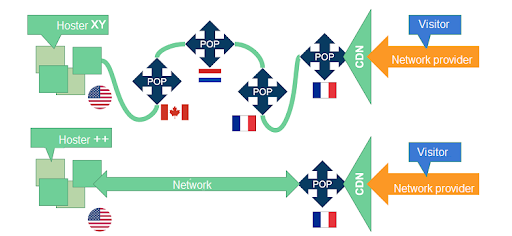
For pages that load quickly, focusing on what appears in the browser by optimizing your frontend seems quite obvious. But do you also pay attention to what’s happening behind the scenes on your servers?
For optimum performance, your backend requires as much attention as your frontend.
Here is some advice about the criteria you should be taking into account so that your infrastructure can hold its own.
Build a chain without a weak link for your performance
The reliability and effectiveness of all of your actions for speeding up your website rely on each link in the chain. If you neglect one, you can weaken the entire system.
So, when you turn to a host, make sure that it offers good bandwidth. For example, if you have a host that’s cheap and doesn’t charge you by the volume or speed of bandwidth, there’s a good chance that your host does not guarantee either speed or latency. For most websites, even those with heavy traffic, speed can be more than sufficient, but latency may pose a real problem. That’s why most hosts offer options to guarantee speed and latency, with additional fees that are typically high.
Naturally, you may have compared this to how phone service providers work: some operate their own network while others make peering agreements. In other words, they use the “leftover” bandwidth from the bigger players and that’s how they’re able to include cheaper plans in their hosting offerings, but those plans have the aforementioned limits related to latency, and thus risks for your web performance.
From your servers to your website users: how your data travel
To better understand, let’s take a closer look at the pathway travelled by data between your servers and your website users, depending on whether or not your host provides their own bandwidth.
Here, we’ll give the example of an international website (the issue would be less evident for a local website) that, of course, wants its users to be able to access its content in as little time as possible, no matter where they are in the world.
If the peering agreements are bad, then there may be many points of presence (POPs) that can be far from one another and reached in an order that can be illogical. Because of this, the data move more slowly, especially if they have to cross seas or oceans:

The upper graphic illustrates the various points through which the data pass when a website is hosted by a provider who doesn’t supply their own bandwidth. The data pass through geographically distant places, adding milliseconds to your loading times.
The lower graphic illustrates the path travelled by data when the host has its own resources. In this case, the path is a straight line, i.e., the shortest path between point A and point B, with practically no stops along the way.
As such, while offers from a host that include bandwidth at no extra charge may be tantalising, you may pay for it later in milliseconds of loading time.
Invest wisely in your infrastructure
The matter of costs is, of course, central to IT project management and unless you’ve found the golden goose, you’ll have to make choices about your investments. Let’s look at why you shouldn’t neglect any aspect.
If you’ve invested in a powerful application on the server side, if would be a shame to let your efforts go to waste with lower-quality hosting.
And if you’ve invested in strong bandwidth without optimizing your application, that can lead to poor usage of that bandwidth.
Similarly, if you get your IT and marketing resources involved in boosting your web performance, it’s a good idea to continue your efforts throughout the entire chain.
That’s also true if you use a solution to automate web performance optimizations because if your frontend is optimized but your backend takes time to respond, you lose some of the benefits of your actions.
To make a long story short, don’t neglect any link in the chain, even those that are less visible like your host! This will help you improve your Time To First Byte, i.e., the time it takes your server to respond, an indicator that affects your SEO.
To go further on how to make your backend more efficient,
go to the 2nd part of our guide where practical advice awaits you!
